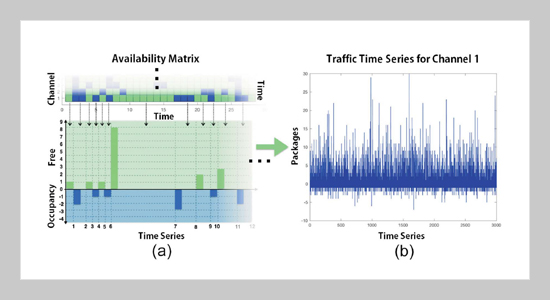REFERENCES
- [1] Al-Tahmeesschi, A., M. López-Benítez, J. Lehtomäki, and K. Umebayashi (2017) Investigating the estimation of primary occupancy patterns under imperfect spectrum sensing, Proc. of 2017 IEEE Wireless Communications and Networking Conference Workshops, San Francisco, USA, 1�6. doi: 10.1109/WCNCW.2017.7919112
- [2] Spectrum Policy Task Force (2002) Public comment on issues related to commission’s spectrum, Federal Communications Commission, Report ET Docket No.02-135, USA.
- [3] Bernal, C., and C. Hernández (2019) Modelo de Decisión Espectral Para Redes de Radio Cognitiva, 1st Ed. UD, Bogotá, Colombia.
- [4] Ding, G., J.Wang, Q.Wu, Y. D. Yao, F. Song, and T. A. Tsiftsis (2016) Cellular-base-station assisted deviceto-device communications in TV white space, IEEE Journal on Selected Areas in Communications 34(1), 107–121. doi: 10.1109/JSAC.2015.2452532
- [5] Frisch, U., and G. Parisi (1985) On the singularity structure of fully developed turbulence in turbulence and predictability in geophysical fluid dynamics and climate dynamics, Proc. of 1985 International School of Physic Enrico Fermi, North-Holland, 71�88.
- [6] Leland,W. E., and D. V.Wilson (1991) High time-resolution measurement and analysis of LAN traffic: implications for LAN interconnection, Proc. of IEEE Conference on Computer Communications, Bal Harbour, USA, 1360�1366. doi: 10.1109/INFCOM.1991.147663
- [7] Taqqu, M. S., V. Teverovsky, and W.Willinger (1997) Is network traffic self-similar or multifractal? Fractals 5, 63�73. doi: 10.1142/S0218348X97000073
- [8] Riedi, R. H., and J. L. Vehel (1997) Multifractal properties of TCP traffic: a numerical study. Institut National de Recherche en Informatique et en Automatique 3129, 1�40.
- [9] Ma, S., and C. Ji (1998) Modeling video traffic in the wavelet domain. In INFOCOM ’98. Seventeenth Annual Joint Conference of the IEEE Computer and Communications Societies. Proceedings. IEEE. San Francisco, CA, USA. doi: 10.1109/INFCOM.1998.659655
- [10] Shenghui, W., and Q. Zhengding (2006) Multifractal analysis and prediction of VBR video traffic, 2006 6th International Conference on ITS Telecommunications Proceedings, 0–3, Chengdu, China: IEEE. doi: 10.1109/ITST.2006.288848
- [11] Hong, L.,Y. Tie, andW. Lanlan (2010) Network traffic prediction based on multifractalMLD model, 2010 International Workshop on Chaos-Fractals Theories and Applications (IWCFTA), 466–470, Kunming, Yunnan, Chin. doi: 10.1109/IWCFTA.2010.109
- [12] Yu, Y., M. Song, Y. Fu, and J. Song (2013) Traffic prediction in 3G mobile networks based on multifractal exploration, Tsinghua Science and Technology 18(4). doi: 10.1109/TST.2013.6574678
- [13] Guan, Q., F. R. Yu, S. Jiang, and G.Wei (2010) Prediction-based topology control and routing in cognitive radio mobile ad hoc networks, IEEE Transactions on Vehicular Technology 59(9), 4443–4452. doi: 10.1109/TVT.2010.2069105
- [14] Zhang, Z., K. Zhang, F. Gao, and S. Zhang (2015) Spectrum prediction and channel selection for sensing-based spectrum sharing scheme using online learning techniques, 2015 IEEE 26th Annual International Symposium on Personal, Indoor, and Mobile Radio Communications (PIMRC), 355–359, Hong Kong, China: IEEE.
- [15] Chen, Y., and H. S. Oh (2016) Spectrum measurement modelling and prediction based on wavelets, IET Communications 10(16), 2192–2198. doi: 10.1109/PIMRC.2015.7343323
- [16] Thakur, P., A. Kumar, S. Pandit, G. Singh, and S. N. Satashia (2016) Performance improvement of cognitive radio network using spectrum prediction and monitoring techniques for spectrum mobility, Proc. of 2016 Fourth International Conference on Parallel, Distributed and Grid Computing, Waknaghat, India, 5�10. doi: 10.1109/PDGC.2016.7913208
- [17] Kim, J., S. W. Ko, H. Cha, and S. L. Kim (2017) Sense-and-predict: opportunistic MAC based on spatial interference correlation for cognitive radio networks, Proc. of 2017 IEEE International Symposium on Dynamic Spectrum Access Networks, Piscataway, USA, 1�10. doi: 10.1109/DySPAN.2017.7920787
- [18] Aref, M. A., and S. K. Jayaweera (2017) Anovel cognitive anti-jamming stochastic game, Proc. of 2017 Cognitive Communications for Aerospace Applications Workshop, Cleveland, USA, 1�4. doi: 10.1109/CCAAW.2017.8001605
- [19] Pedraza, L., F. Forero, and I. Paez (2013) Metropolitan spectrum survey in Bogota Colombia, Proc. of IEEE International Conference on Advanced Information Networking and Applications Workshops, Barcelona, Spain, 548�553. doi: 10.1109/WAINA.2013.177
- [20] Hernández, C., and D. Giral (2015) Spectrum mobility analytical tool for cognitive wireless networks, International Journal of Applied Engineering Research 10(21), 42265–42274.
- [21] Kleinrock, L. (1975) Queueing Systems: Vol. I: Theory. 1st Ed. JohnWiley & Sons, Inc, New York.
- [22] Leland, W. E., M. S. Taqqu, W. Willinger, and D. V. Wilson (1994) On the self-similar nature of ethernet traffic, IEEE/ACM Transactions on Networking 2(1), 1–15. doi: 10.1109/90.282603
- [23] Millán, G. (2009) Análisis de Autosimilaridad de Tráfico Telemático Restringido al Nivel de Red,MSc. thesis, Pontificia Universidad Católica de Valparaíso, Chile.
- [24] Tuberquia-David, L. M., H. López, and C. Hernández (2019) A Multifractal Model for Cognitive Radio Networks, 1st Ed. UD, Bogotá, Colombia.
- [25] Murali, K. P., V. M. Gadre, and U. B. Desai (2003) In Multifractal Based Network Traffic Modeling, 1st Ed. Springer, Boston, USA. doi: 10.1007/978-1-4615-0499-3_1
- [26] López Chávez, H. I. and M. Alzate (2012) Generation of LRD traffic traces with given sample statistics, Proc. of 2012 IEEE Workshop on Engineering Applications, Bogotá, Colombia, 1�6. doi: 10.1109/WEA.2012.6220077
- [27] Riedi, R. H., M. S. Crouse, V. J. Ribeiro, and R. G. Baraniuk (1999) A multifractal wavelet model with application to network traffic, IEEE Transactions on Information Theory 45(3), 992–1018. doi: 10.1109/18.761337
- [28] Tuberquia-David,M., F. Vela-Vargas, H. López-Chávez, and C. Hernández (2016) Amultifractal wavelet model for the generation of long-range dependency traffic traces with adjustable parameters, Expert Systems with Applications 62, 373–384. doi: 10.1016/j.eswa.2016.05.010
















